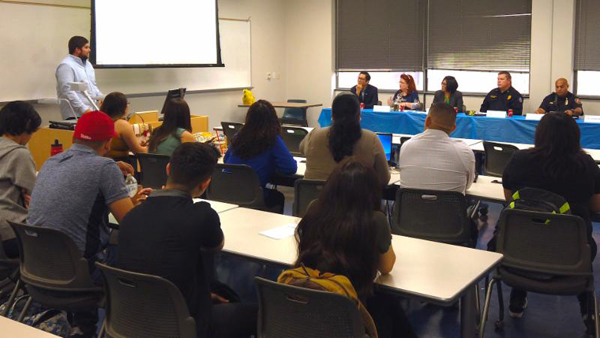- La Feria Community Holds Succesful Business Mixer Event
- Little Nashville to Take Place in Downtown Mercedes
- Lions Basketball Captures District Gold
- La Feria ISD Students Compete in Regional Chess Tournament
- Lions End First Half of 32-4A on a High Note
- La Feria ISD Held Another Successful Parent Conference
- Strong Appearance for Lions at Hidalgo Power Meet
- LFECHS Students Get to Meet Local Actress
- Students Participate in Marine Biology Camp
- Two LFECHS Students Qualify for All-State Band
UTRGV Students Share Disaster Preparedness Research Findings with Area Officials
- Updated: June 14, 2019
by Maria Elena Hernandez
RIO GRANDE VALLEY, TEXAS – There are almost 180,000 people in the Rio Grande Valley living with a disability, and most are not prepared to deal with a disaster like a hurricane.
Recent findings like those from students in a disasters studies course at The University of Texas Rio Grande Valley showed a disturbing trend of unwillingness among area residents to abandon their homes in favor of personal safety.
“We were surprised that so many respondents were unwilling to evacuate,” said Lisa Tresnicky, a UTRGV senior from Mercedes who is majoring in sociology. “That just showed how important it is that we share this information and that we spread the awareness of how critical it is that they do prepare and take a proactive approach to disaster preparedness.”
Related Link: Team of UTRGV professors researching the Valley’s hurricane preparedness
FILLING RESEARCH VOID
Tresnicky was one of a group of UTRGV students who presented their research findings to local emergency management officials during a panel forum in May.
Antonio Lopez, Weslaco emergency management coordinator, was one of the panelists.
“We are a lot of times tasked with the response, the mitigation and the recovery of things,” he said. “We don’t have a lot of time to do that research. So, when we partner up with the university to bring that data to us, it’s going to make our response a lot better.”
Lopez said some of the numbers presented were higher than expected.
“The research from the four groups from this program really puts it into perspective for us,” he said.

A group of UTRGV students recently presented their research findings on public disaster response to local emergency management officials, during a special panel forum. Almost 180,000 people in the Valley live with a disability, the students found, and many are not prepared to deal with a disaster like a hurricane. Dr. Dean Kyne, UTRGV assistant professor in the disaster studies program, said the research shows a disturbing trend of unwillingness among area residents to evacuate, preferring to remain in their homes rather than ensuring their personal safety. Area emergency management representatives who attended said collaboration with the university on the research data helps with disaster preparation efforts. Courtesy Photo
SHARING INFORMATION DIRECTLY
Dr. Dean Kyne, a UTRGV assistant professor in the disaster studies program, said disaster preparation can be a very complicated process.
“Now the students know there are a lot of challenges for the preparedness, especially for the disabled population. The complexity is there,” he said.
The conventional way to share research is by publishing in a peer-reviewed journal. And while there are plans to publish the findings, Kyne said that as part of the course’s service-learning component, “We have to provide the findings directly to the end-user, who are the emergency managers here.”
SEEING THE STUDY’S IMPACT
While the overall goal of the research is to improve the Valley’s disaster resiliency and sustainability, the forum also helped students see the value of their work.
“It was a great opportunity to share the data we gathered with key stakeholders in the community,” Tresnicky said. “It made me feel that what we did is important. Our data can help enhance the preparedness of this vulnerable population.”
Lopez, the Weslaco emergency management coordinator, said he is optimistic about future disaster communications in the Valley.
“By getting this research – and hopefully in the future continuing the collaboration with the UTRGV disaster studies program – this will give us all the data we need to continue improving,” he said.
To learn more about the UTRGV disaster studies program, visit https://www.utrgv.edu/sociology/graduate/disaster-studies-ma/index.htm
To learn how to prepare for a disaster, visit ready.gov.


